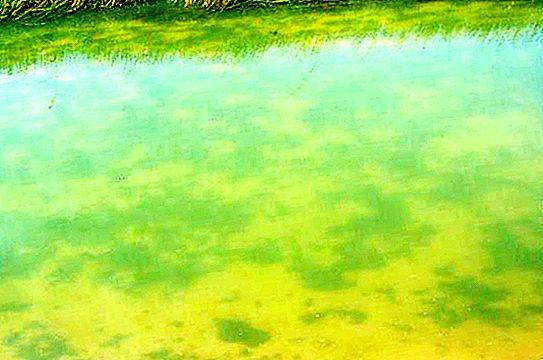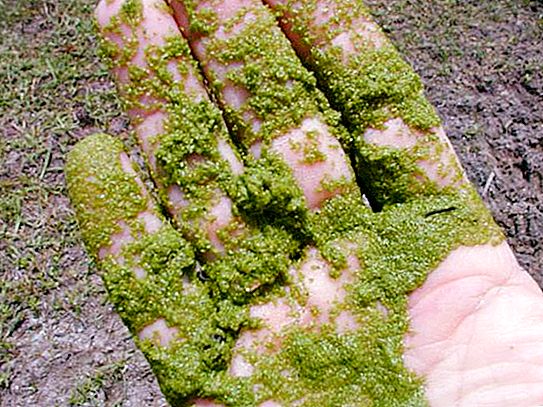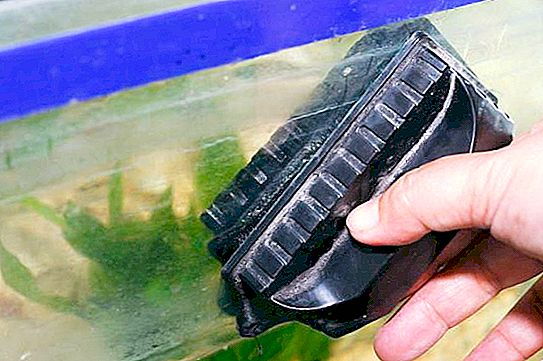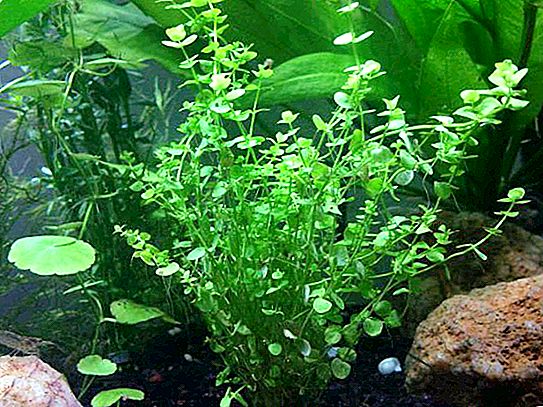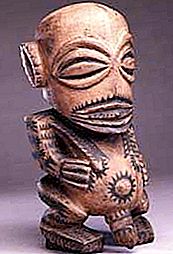Filamentous algae, barely appearing in the aquarium, begin to grow rapidly, braiding plants and stones with thin threads. In a matter of days, the thread can completely fill the indoor pond. When growing, algae release a large amount of waste into the water, interfere with plant growth, and become a web in which fish fry can become entangled or particles of food become stuck. All this becomes the cause of the activation of rotting processes. If you take no action and start the problem, green filamentous algae can lead to the death of the entire ecosystem.
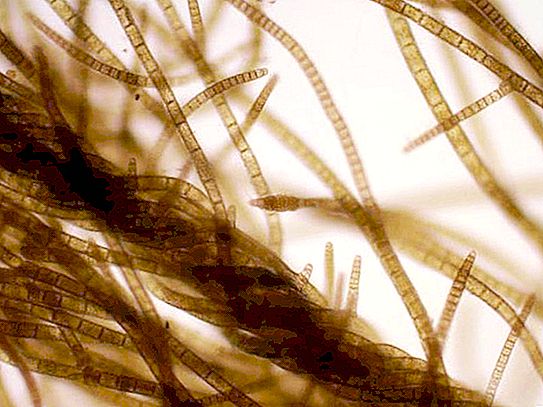
How are algae different from plants?
All representatives of the plant kingdom from the point of view of biology are divided into higher and lower. Plants, including aquarium ones, are rather complexly organized creatures having various sections in their structure: the root system, leaves, stem, shoots, flowers and fruits.
Examples of fairly unpretentious aquarium plants in care are duckweed, limnobium, elodea, wallysneria, and hornwort. These residents of the indoor pond carry out photosynthesis, during which they remove carbon dioxide and release oxygen, absorb phosphates, nitrites and nitrates, cleansing the aquarium, are indicators of the state of the ecosystem and additional food for its inhabitants.
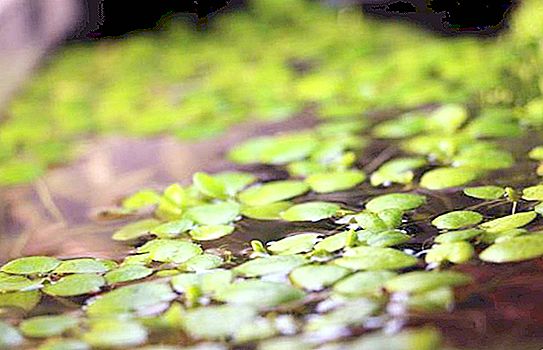
Algae are representatives of lower plants, protozoa. Their structure is much more primitive than the representatives of the higher group (flowering or seed plants) - organs do not stand out from algae, they consist of one or several types of cells in which complex biochemical processes occur. Algae are divided into unicellular and multicellular. The main feature that distinguishes lower plants is the reproduction of spores.
A variety of algae is conventionally divided into departments. The simplest of them are blue-green algae, while the rest of the group is more complex. In aquariums you can find brown, green, diatom and red algae. Brown algae are a frequent “guest” of home reservoirs lacking enough natural light in winter, and the increased content of organic substances in aquarium water often leads to activation of blue-green representatives of the group.
Why do algae appear in the aquarium?
Filamentous algae in the aquarium are actively growing and rapidly occupy almost the entire area of the home reservoir under the following conditions:
- increased water hardness;
- insufficient number of aquarium plants;
- irregular water changes;
- poor cleaning, which causes the accumulation of nitrates necessary for the growth and development of nitrate;
- insufficient oxygen supply;
- too bright lighting: thread appears more often if artificial lighting is used for more than eight hours a day or direct sunlight enters the aquarium.
Beginning aquarists encounter thread in those cases when higher plants have not yet taken root in the ecosystem and there is an overabundance of trace elements necessary for the active development of protozoa. Sometimes you can bring green algae along with new aquarium plants.
Why are algae dangerous?
Active propagation of filamentous algae leads to the fact that organisms literally in a few days fill the entire space in the aquarium. They join in bundles, entangle plants, making it difficult for them to grow and develop, clog filters and other equipment, and attach to snags. Toxic substances released by filamentous algae in large quantities have a detrimental effect on the inhabitants of the aquarium. In the threads of the algae, fry and small fish can become entangled, the remains of the feed and other organic substances get stuck.
What do algae look like?
Green filamentous algae is a representative of one of the groups, often delivering unnecessary trouble to aquarists. One of the signs of the active propagation of green algae in a domestic pond is the visible turbidity and greening of the water. Externally, the thread looks like thin green threads. Algae is slimy, soft to the touch, when removed from the water, it immediately loses its shape and sags. The development of filamentous algae occurs due to the absorption of nutrients dissolved in water, and the process of photosynthesis.
Why does thread so quickly “conquer territory”?
Filamentous algae grows rapidly under favorable conditions. The method of propagation contributes to the rapid spread of filament in an artificial pond: algae breaks up into separate sections, each of which forms a new thread. Filamentous algae also reproduce by spores. In the latter case, spores with flagella attach to the ground and germinate.
What are the types of algae (filamentous)?
Two varieties of filamentous algae can be present in the aquarium: directly green strands floating freely in the water, and shorter ones, usually accumulating on the glass surface and plant planes. Different types of green algae have different “preferences” in terms of living and nutrition, so the methods of dealing with them are different.
Filamentous algae include:
- Spirogyra. Algae has the form of long bright green "strands", which are collected in a kind of nest. The threads are soft, easily kneading fingers. Most often, spirogyra settles near young plants, and an excess of nutrients and light contribute to a surge in algae activity.
- Nitty This species combines many very similar algae. Long threads are attached to old driftwood or stones in well-lit areas; colors can range from dark or light green to grayish or black.
- "The Fluff". At an early stage of development of filamentous algae, the “fluff” covers the leaves and stems of plants. The appearance of such algae indicates malnutrition in the aquarium and the poverty of the soil substrate.
- Chlorella and Chlamydomonas. The simplest algae are part of the natural life process in natural reservoirs, while in the aquarium they can become a real disaster. Chlorella and chlamydomonas are precisely those unicellular that cause the "bloom" of water.
- Ulotrix. Ulotrix filamentous algae forms coils that connect together. Algae covers well-lit walls and soil of the aquarium.
What are the ways to deal with thread?
There are several methods to deal with thread, it is better to approach the problem comprehensively. You can get rid of algae as follows:
- by mechanical cleaning;
- creating unfavorable conditions for the growth and development of algae;
- biological and chemical methods.
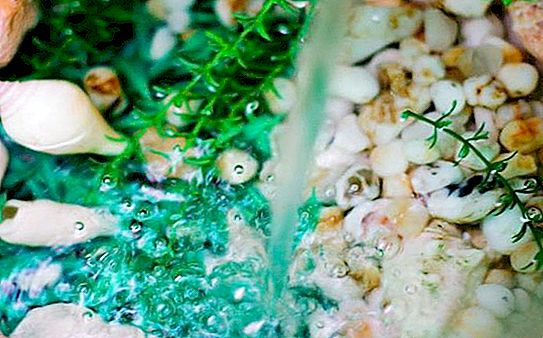
How to mechanically remove algae?
Where to start fighting? Filamentous algae, which may leave the artificial pond after mechanical cleaning, are spirogyra and filament. In the fight against other organisms, mechanical removal will be only the first step.
So, it is necessary to thoroughly clean the walls of the aquarium from greenish deposits. To simplify the procedure, there are many special devices: scrapers that work on the principle of a razor, graters with a magnet that allows you to control the process through the glass. However, in practice, it is easiest and most effective to clean the walls of the aquarium with an ordinary dishwashing sponge. By the way, soft sponges do not leave scratches, which are typical when using special scrapers.
To clear decorative elements, driftwood and stones from plaque is a little more difficult. But here there is a simple and reliable way - the old toothbrush proved to be the most effective tool. Rigid bristles and small size allow you to carefully process uneven surfaces. Together with mechanical cleaning, it is imperative to change the water in the aquarium.
What conditions are unfavorable for nitrate?
The fight against filamentous algae also involves the creation of unfavorable conditions for their reproduction and development. So, it is necessary to reduce the brightness of the lighting, and if the aquarium is in direct sunlight, darken it with white paper or gauze. Algae will die under specially darkened lighting. Three days is enough to get rid of the fiber in this way.
In addition, it may be worthwhile to increase the number of aquarium plants. Living plants are necessary to maintain a harmonious life of an artificial reservoir, otherwise their place will be occupied by algae. It is also important to ensure good aeration - a sufficient supply of oxygen will allow plants to feel good and inhibit the growth of algae.
Which aquarium inhabitants eat algae?
The inhabitants of the artificial reservoir will also help to combat the excessive amount of filamentous algae. Some species of fish feed on algae, controlling their distribution. So, to normalize the ecosystem, sometimes it is enough to start a fish called Antsistrus ordinary. The natural enemies of algae are also:
- daphnia crustaceans;
- molliesia;
- barbs
- shrimp
- snail coils;
- Pecilia
- guppies and other viviparous fish.
What drugs inhibit the development of fiber?
It is not always possible to cope with the activation of algae growth by exclusively "natural" methods. In some cases, it is worth using chemicals that can be purchased at aquarium or zoological stores. From filamentous algae, introducing bicillin-5 and penicillin into the artificial pond helps.
How to prevent the appearance of algae?
To prevent the appearance of filament in the aquarium, you need to know not only what is the reason for the appearance of parasitic algae, but also what conditions are needed for normal life. Lighting is one of the important factors. Direct sunlight or simply bright light contributes to the emergence and spread of algae, so the aquarium should not be left under powerful lighting for a long time.
It is also believed that a high content of nitrates and phosphates causes an increase in the growth of this algae. Substances are part of fertilizers for aquarium plants, but still it is not worth completely refusing additional feeding, since fertilizers are still necessary. So, in plants you need to fertilize normalized.
In order not to bring the parasite algae together with new plants, you need to control everything that is planned to be placed in an artificial reservoir. If any signs of nitrite are noticeable on new plants or decorative elements, you need to wait a bit with the purchase.
When cleaning the aquarium, all plants should be thoroughly washed with water and cleaned. Soil should be dealt with in a similar manner. With regular cleaning of the soil, the risk of nitrite is significantly reduced. Good in the prevention of nitrate are potassium permanganate or hydrogen peroxide. However, all of the above methods do not help much if algae has already appeared in the aquarium. In this case, you should first get rid of the parasite.


